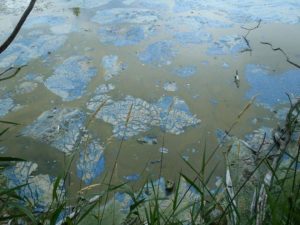Update: Lake Cornelia Safe for Use
Lake Cornelia Safe for Public Use
October 3, 2016
Update: Both the South Basin and North Basin of Lake Cornelia are safe for use by the public.
Current testing results show that the algal toxin levels in both basins of Lake Cornelia have dropped below thresholds of concern. The lake is safe for use. The engineering firm for the Nine Mile Creek Watershed District will not conduct any further monitoring this season on Lake Cornelia.
Toxic Algae in Lake Cornelia’s South Basin
September 27, 2016
The public is advised to have no contact with the water in Lake Cornelia’s South Basin. Lake Cornelia’s North Basin is now safe for use by the public.
Further testing results have shown that algal toxin levels are now substantially below thresholds of concern for the North Basin of Lake Cornelia, and the water in the North Basin is now safe for contact. Algal toxin levels have dropped in the South Basin of Lake Cornelia, but near shore samples still indicate that people and pets should not ingest or have any contact with the water in the South Basin. The engineering firm for the Nine Mile Creek Watershed District will take another sample in the South Basin on September 28 to continue to monitor the toxin levels.
For more information on harmful algal blooms visit:
https://www.pca.state.mn.us/water/blue-green-algae-and-harmful-algal-blooms
http://www.health.state.mn.us/divs/idepc/diseases/hab/hab.html
Toxic Algal Alert: Lake Cornelia
September 16, 2016
The public is advised to have no contact with the water in Lake Cornelia.
The City of Edina and the Nine Mile Creek Watershed District have confirmed that a harmful algal bloom has occurred on Lake Cornelia and are urging residents to stay away from the water due to public health concerns. Harmful algal blooms are blue-green algal blooms that contain toxins that can cause illness in humans and animals. Walking on the path around the lake is safe, as long as you or pets do not have contact or ingest the water.

Blue-green algae are a type of cyanobacteria present at low levels in many Minnesota lakes and ponds. When water is stagnant, warm and rich in nutrients – especially phosphorus – cyanobacteria can grow quickly, forming “blooms.” These blooms typically look like pea soup or bright green paint. They can produce a strong, swampy odor as the cyanobacteria breaks down.
“The City is working with Nine Mile Creek Watershed District and an engineering consultant to strategize solutions for the problem,” said City of Edina Water Resources Coordinator Jessica Vanderwerff Wilson.
According to Nine Mile Creek Watershed District Education and Outreach Program Manager Erica Sniegowski, phosphorus pollution is a common urban water quality issue. “Our infrastructure was designed to collect runoff from streets. This runoff flows untreated to local bodies of water. Pollutants gather in these areas and often create high levels of phosphorus, which can lead to harmful algal blooms,” she said.
Continuing efforts to gain control of the algae include weekly monitoring at the lake’s north and south basins until the levels drop. The Watershed District and the City will work together closely to develop ongoing solutions for controlling the harmful algae. The Nine Mile Creek Watershed District Board will meet to discuss recommendations for next steps.
Lake Cornelia is treated twice per year by lake restoration companies. Among other things, the City will continue to do regular algae treatments in conjunction with other ongoing control efforts.
A meeting with residents will be held sometime in November.
For more information, contact Wilson at 952-826-0445 or Sniegowski at 952-358-2276.
Save
Save
